365 Days in Horse Country – Horse Cloning

Some mares become pregnant in a not-so-natural way. Cloning has hit the equine world, although
not in every field.
Biological cloning is the process of producing genetically identical individuals. Italy produced the first cloned horse in 2003. In North America, the first cloned horse was produced at Texas A&M University in 2005.
Cloned embryos are produced by placing the DNA-bearing nucleus of a horse’s cell into tn unfertilized egg that has its nucleus removed. When the egg develops into an embryo, it is then implanted in a mare’s uterus and carried to term. The resulting foal shares the DNA of the horse whose DNA was used to create the embryo. The mares that carry the embryos are screened for health and temperament, and watched closely when delivery is near to ensure that nothing goes wrong. The cloning process is extremely expensive, considerably more than most stud fees.
Cloning is of interest to horse owners who want to preserve or continue the genetic makeup of their performance horses. Equine sports that permit cloned competitors include carriage horse racing, endurance horse racing, cutting, dressage, polo, and show jumping. In dressage, for example, many of the horses are geldings. Cloning is a way to preserve and reproduce the genetic lines of an outstanding horse that otherwise couldn’t produce offspring.
Not all horse registries permit cloning. The Jockey Club, which oversees the registration of Thoroughbreds, does not permit the registration of any foal produced by artificial insemination, embryo transfer or transplant, cloning, or any other form of genetic manipulation. The Jockey Club uses DNA testing to ensure that all foals registered were bred naturally. The American Quarter Horse Association (AQHA) also prohibits the registration of clones.
It remains to be seen whether horses created with the reproductive technology will be as healthy as the originals, or if they will be affected by the health problems that have plagued some other cloned animals, such as a shortened life span and immune-system dysfunction.
Michael







